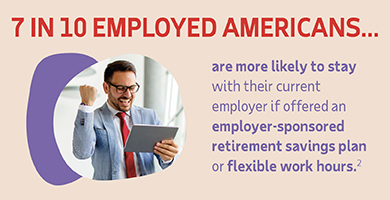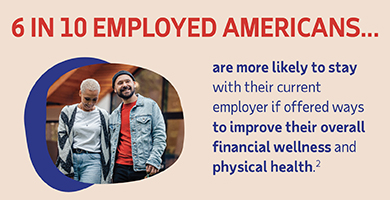
Inflation has been in the headlines recently, and for good reason. The rising cost of goods and services impacts everything from how much businesses spend on supplies and labor to how individuals manage their personal finances at home. For worksite employees trying to save, those nearing retirement, or those recently retired, it’s an especially significant concern. Most employees plan to live on a fixed income once they retire. When costs of goods and services increase beyond what pre-retirees have projected, it can impact the standard of living they’re planning on or even delay their retirement altogether.
In the U.S., the core Consumer Price Index – which excludes volatile food and energy prices – was up 4% for the 12 months ending September 2023, which is the lowest it’s been in two years.1 But while inflation rates have been declining from record highs, the risk that inflation poses is still top of mind for worksite employees approaching retirement, as well as retirees. Eight-in-10 working Americans worry inflation will impact their ability to save for retirement, an increase of four percentage points from the previous year.2 Fortunately, employers can educate their worksite employees about the impact of inflation and employ benefits that ensure their worksite employees are on track for a successful retirement.
The inflation challenge
Some amount of inflation is an expected component of economic growth. In fact, the Federal Reserve aims for an inflation rate of 2%, which it says is ideal for sustaining employment and economic expansion.3 But trouble arises when inflation rises too quickly, and the rate exceeds what financial advisors and people planning for retirement have accounted for in their plans. For example, higher prices often mean the amount of money worksite employees are planning to save for retirement isn’t enough to last through the end of their lives. Alternately, inflation beyond what’s planned for can also mean they may need to plan for a lower standard of living in their retirement. A Voya survey from June 2023 shows the effect of inflation in action, with 87% of working Americans reporting their money doesn’t go as far as it used to and 78% saying inflation has made them more stressed about their financial situation.2
Inflation can also impact Social Security payouts. The Social Security Administration does review distributions with inflation in mind, but the government’s cost-of-living adjustment (COLA) has historically trailed current inflation figures. Finally, the higher interest rates that often accompany inflation can also affect worksite employees’ ADP TotalSource Retirement Savings Plan (the “Plan”) accounts. In some instances, the interest rates may give a boost to retirement savings that are in lower-risk vehicles such as CDs, Money Market Accounts or high-yield savings accounts. But higher interest rates can also make it more difficult for worksite employees to purchase real estate or sell their home (home sales often slow during periods of high interest rates) once they do retire. The bottom line: inflation impacts retirement plans in big and bigger ways, and worksite employees need a strategy for navigating rising costs.
An employer priority
The impact of inflation on retirement planning isn’t just a worksite employee concern; it’s something employers should also consider. Worksite employees rely on employer-based plans to help facilitate their retirement via tax-advantaged savings and employer contributions. Moreover, they often depend on guidance provided via their benefits to help steer them through retirement planning.
Offering worksite employees support in their retirement journey pays off for employers as well. For example:


Retirement plans and guidance are an important component of an employer’s benefits package, helping worksite employees reach their retirement goals and ultimately helping employers fulfill their corporate social responsibilities and support the communities they live in.
The role of benefits
The Plan is a key way that you, as the employer, can help your worksite employees plan for their income after they’re done working. However, in addition to the Plan, voluntary and supplemental benefits also empower pre-retirees to plan more successfully for their future.
Consider how the following benefits enable your worksite employees to buffer the impact of inflation and better plan for retirement:
- Supplemental health insurance. Supplemental health insurance can help current employees prepare for unexpected health emergencies. Accident, hospital indemnity and cancer insurance offer additional protection, preventing employees from potentially mining their retirement savings to cover health care expenses.
- Disability insurance. Sometimes, a significant illness or accident can force a worksite employee to retire early or miss out on earnings they were counting on for retirement; disability insurance can provide an income source and help sustain their retirement savings that much longer.
- Savings vehicles and investment guidance. Health Savings Accounts, Flexible Spending Accounts and other tax-advantaged accounts can also help navigate inflation by helping maximize their savings potential. Additional financial guidance benefits can help worksite employees create a retirement plan with contingencies that account for inflation.
- COLAs. Offering COLAs that at least match inflation provide another way employers can help pre-retirees. By maintaining salaries that reflect inflation increases, worksite employees can save and plan better.
For worksite employees planning to retire within the next few years, inflation remains a real concern. Employers can help employees navigate their pending retirement in multiple ways, including providing benefits that help employees make more informed savings and spending decisions.
-
https://www.bls.gov/news.release/pdf/cpi.pdf
-
Based on the results of a Voya Financial Consumer Insights & Research survey conducted June 12-13, 2023, among 1,004 adults aged 18+ in the U.S., featuring 483 Americans working full-time or part-time.
-
https://www.federalreserve.gov/faqs/economy_14400.htm#:~:text=The%20Federal%20Open%20Market%20Committee,maximum%20employment%20and%20price%20stability




